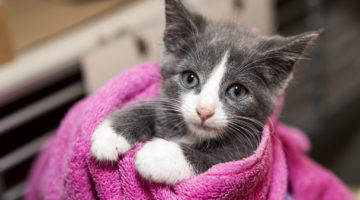Cats can get set in their ways. And the older they are, the truer this becomes. If you have an older cat, and are considering adopting a kitten to add to the household, you need to make sure you know what you’re doing so you don’t end up with two stressed-out felines that can’t get along.
Old cat vs. kitten
People frequently assume that getting a young exuberant kitten as a companion for an elderly cat will help perk up the senior’s spirits. In reality, however, bringing home a kitten is likely to make the older cat’s life more uncomfortable.
“Bringing a new alien scent of the same species into the house will be very stressful for your resident kitty, and more times than not, you’re asking for chaos,” says veterinarian Dr. Jean Hofve. “Additionally, an older cat will not take kindly to a kitten she perceives as a pesky, frolicking ‘intruder’ infringing on her domain.”
Older cats thrive on an established routine and can be very territorial. When that routine is shattered, it can be extremely stressful for a senior cat, especially when she’s faced with a youngster who is bursting with energy and constantly pestering her to play. It could even lead to aggression on the part of the older cat.
“Kittens and older cats are at totally different stages of life,” says Dr. Hofve. “Elderly cats don’t have the same interests or energy levels as kittens. This age difference becomes extremely frustrating for youngsters who don’t have an outlet for romping and playing and dissipating their energy. It’s also significantly irritating for a senior kitty who might greatly prefer to spend time napping by a window in the sunlight.”
Adopt two kittens instead of one
If your heart is set on bringing a kitten home, Dr. Hofve recommends adopting two instead of one. This may seem counterintuitive, but it means the kittens will be far more likely to play with one another and leave the older cat in peace. “Adopt littermates or two kittens from the same shelter who know each other,” Dr. Hofve says.
- Before adopting the kittens, be sure they’re in good health so they won’t pass anything on to your senior. Ask shelter staff for the kittens’ health records, make sure they have received their core vaccines, and are parasite-free.
- After you adopt them, make an appointment to take them to your veterinarian as soon as possible for a wellness exam, including a thorough physical, stool check, and tests for FLV and FIV.
- Before beginning the introduction phase, isolate the kittens for several days in a safe room. It should contain two litter boxes, a scratching post, water bowls (washed and refilled daily), some toys, a snuggly cat bed, and a couple of boxes for hiding places.
Introducing the kittens to your resident cat
The introduction phase can take weeks to complete, so be patient. The process must never be rushed, because if things go awry, it can permanently damage the cats’ ability to bond.
“It’s most important that all associations between your cat and kittens during this critical period are as pleasing as possible to reduce possible friction when they finally have free access,” says Dr. Hofve. She offers some great steps to a smoother transition:
- Switch the cat’s and kittens’ locations daily. Put the older cat into the kittens’ room for a few hours, while letting the kittens run freely to explore the house. Reverse the process and repeat for several days. You may need a helper to ensure the cats don’t come into direct contact with one another.
- Get a dry washcloth and gently rub it over your older cat’s cheeks, head, sides, and around the base of her tail. Then present the kittens with the scent of the washcloth near their safe room hangout. Do the same thing the other way around. This lets all the kitties know they will be sharing space with one another. Scent is much safer than visual contact.
- Feed your cat and kittens on opposite sides of the door to the safe room, but keep the door closed. Leave a few feet of breathing room for each cat or kitten. Ideally, there should be a helper on either side of the door to praise each feline as he or she eats. The idea is that the cat and kittens are rewarded with food for being so close to the scent of one another, and rewarded with praise from you for eating. Even if they don’t devour their food right way, they will eventually eat.
- The next step is to open the door a tiny crack, giving your cat and kittens limited visual access to each other. Using rubber doorstops on either side of the introduction door prevents anything more than visual accessibility.
Again, proceed slowly. Remember that rushing the process can mean having to go back to the first step for a few days or even weeks. With time and patience, however, you should eventually be able to allow the kittens to mingle freely with your cat, and even make friends with her.







No Comment